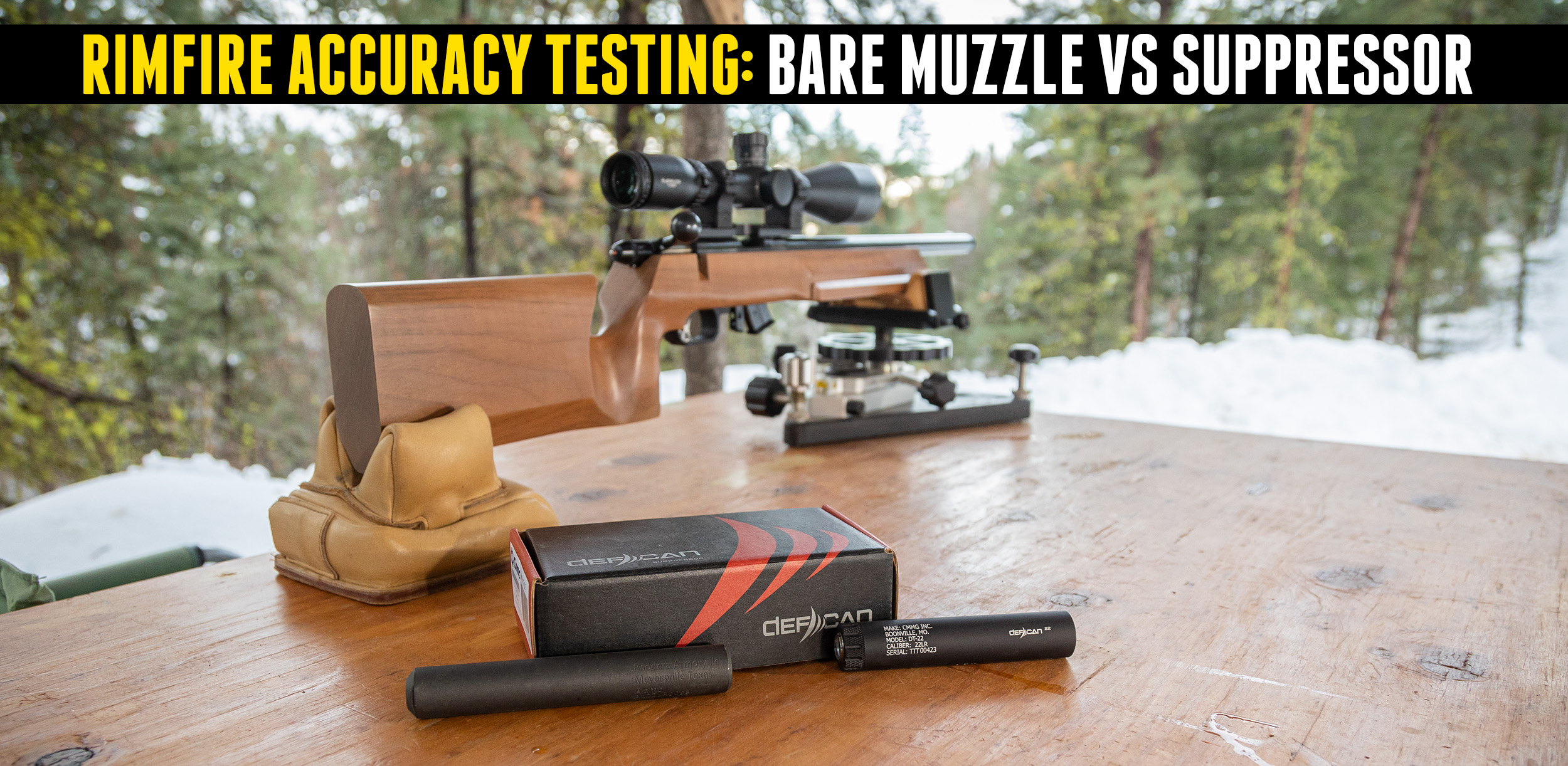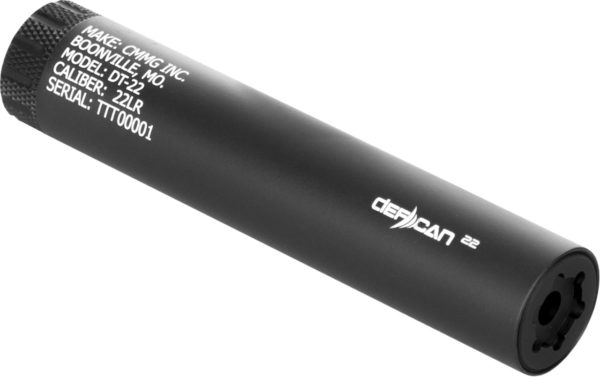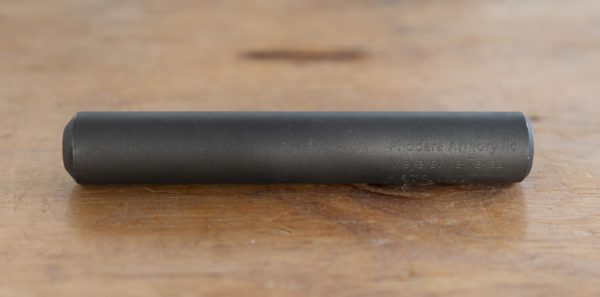How do rimfire suppressors affect accuracy? We did some testing with the Anschutz 54.18 BR50-U7 to find out.
Disclaimer
Ultimate Reloader LLC / Making with Metal Disclaimer: (by reading this article and/or watching video content you accept these terms). The content on this website (including videos, articles, ammunition reloading data, technical articles, gunsmithing and other information) is for demonstration purposes only. Do not attempt any of the processes or procedures shown or described on this website. All gunsmithing procedures should be carried out by a qualified and licensed gunsmith at their own risk. Do not attempt to repair or modify any firearms based on information on this website. Ultimate Reloader, LLC and Making With Metal can not be held liable for property or personal damage due to viewers/readers of this website performing activities, procedures, techniques, or practices described in whole or part on this website. By accepting these terms, you agree that you alone are solely responsible for your own safety and property as it pertains to activities, procedures, techniques, or practices described in whole or part on this website.
About the Anschutz 54.18 BR50-U7:
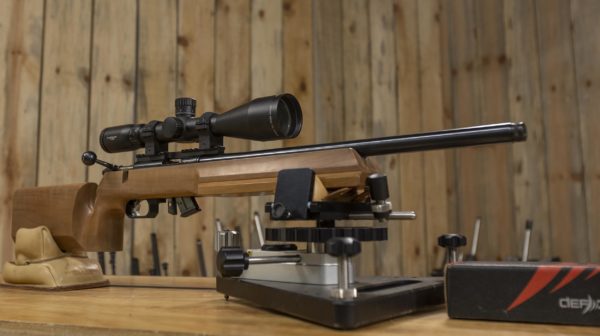
I’ve especially enjoyed shooting Anschutz rifles. They are wonderful to test with because they are incredibly accurate. While I’ve featured both the Anschutz 1710 Competition 22LR and Anschutz 54.18 BR50-U7, I decided to use the benchrest rifle to test rimfire accuracy with suppressors. I shot my best rimfire group ever when I visited Anschutz and shot this model in their underground range. We now have our own 54.18 at Ultimate Reloader. It has a 20” barrel, match chamber, threaded muzzle (½ x 28), 5018 two-stage trigger (2.4-7.0 z. 2nd stage), 10-round magazine and walnut stock. One of our best five-shot groups with this rifle measured 0.289” at 50 yards.
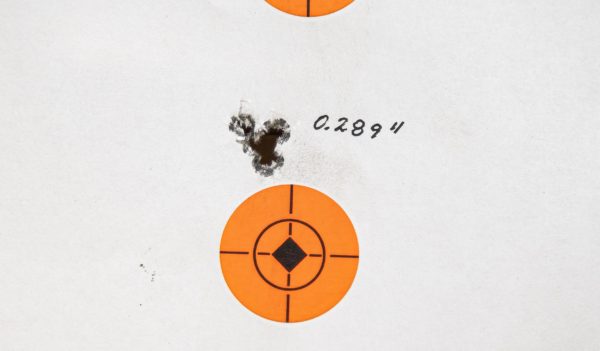
I’m still testing various types and lots of ammunition and techniques with this gun as it’s my first benchrest rimfire.
Sinclair Windage-Adjustable Benchrest
The Sinclair Competition Shooting Rest has proven to be a GREAT piece of shooting equipment, here’s our video covering that rest:
About the CMMG DefCan 22
The CMMG DefCan 22 has a 40 dB sound reduction, 5” length, and 1” diameter. It weighs 2.7 ounces, is hard coat anodized and has a direct thread ½ – 28.
From CMMG:
DefCan 22 (.22LR, DT 1/2 – 28)
Rimfire suppressors are fun to use and a great starting point for those looking for their first can. CMMG’s DefCan 22 suppressor amplifies the fun factor with 40 dB reduction in sound. Weighing just 2.7 ounces, the DefCan 22 is extremely lightweight. Its small frame adds very little length to the end of your rifle. Available for an MSRP of just $324.95, the DefCan 22 offers an impressive value and is backed by CMMG’s Lifetime Guarantee. Can be utilized with: .22 Short, .22 Long, .22LR, .22 Magnum, .17HM2 and .17HMR. Not full-auto rated.
-
- Caliber: .22 Long Rifle
- Sound Reduction: 40dB
- Length: 5″
- Diameter: 1″
- Weight: 2.7oz
- Finish: Hard Coat Anodized
- Attachment: Direct Thread 1/2-28
About the Phodera Armory Alamo
The Phodera Alamo is 5” long with a diameter of 0.945”.
This model has been in production since the early 1990s and further refined over the years. It is made in Texas, has a direct thread mount, and is “practically maintenance free” according to Phodera Armory.
From Phodera:
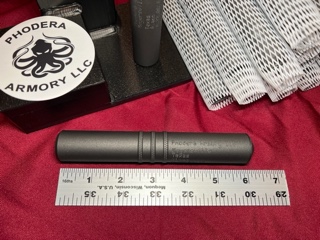
PHODERA ARMORY SUPPRESSORS
PHODERA SUPPRESSORS ARE CALIBER-SPECIFIC,DIRECT-THREADED AND ARE DESIGNED AND BUILT FOR PERFORMANCE, ENDURANCE AND ACCURACY.
WE INCORPORATE:
-
- Sound Suppression
- Flash Elimination
- Recoil Reduction
- Signature Elimination
- Improved Accuracy
- Higher Duty Cycle
- Practically Maintenance free
We use proprietary materials and incorporate the Laws of Math and Physics to produce a Suppressor that will last you a lifetime. Direct-Threaded for the Purist.
Our product has been in constant production since the early 1990’s, with sales concentrated in the European markets. Our Research and Development was made possible by a 5th generation Gunsmith with proven results.
Setting up the Test
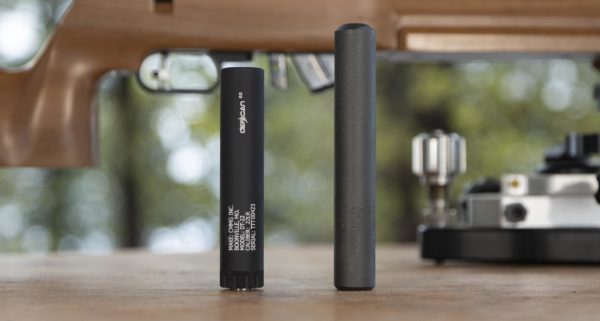
Both the Phodera Armory Alamo and DefCan 22 work very well, but have their differences. The DefCan is lighter and has a larger diameter, but the Alamo is longer and heavier with more internal volume. The DefCan is user-serviceable while the robust Alamo is practically maintenance-free and originally intended for the European markets.
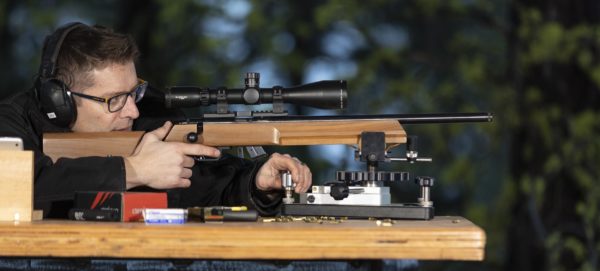
I wanted to compare accuracy when shooting the Anschutz 54.18 with each suppressor and bare muzzle (with the thread protector). I began testing various SKUs at 100 yards with just the thread protector installed. I would typically begin the test at 50 yards, but with all the snow, I didn’t have a 50 yard range set up with a bench. This test is not particularly scientific, but served as a way to narrow down the lots of ammunition that shot well.
I worked with different lots of Lapua Center-X, Lapua Midas + and R50.
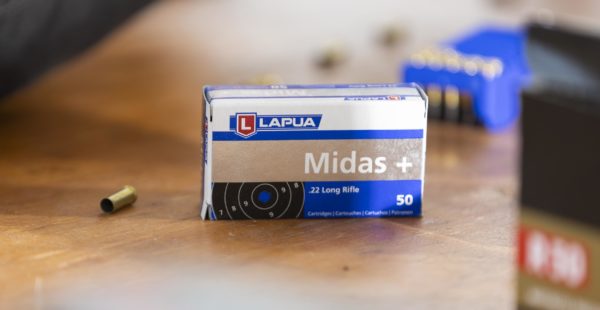
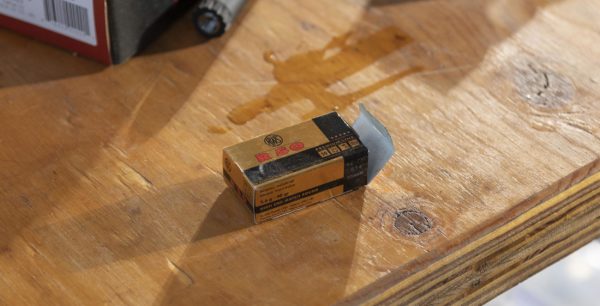
Any ammunition that looked promising I would test with all configurations. After narrowing the field, we were able to construct a temporary 50 yard range to continue testing. As stated earlier, this test was not scientific. We didn’t run equivalent tests at 50 and 100 yards and we would need more data for each combination.
The Test
Our informal test was just to see what would happen. We fired two strings for each configuration and took the best group for each configuration to compare.
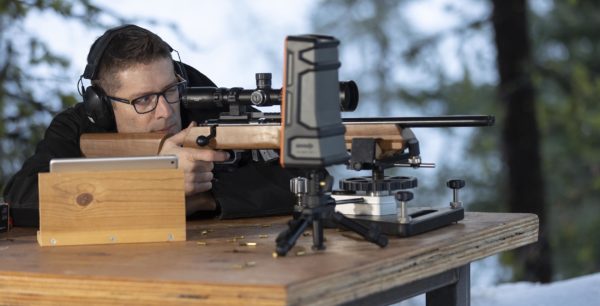
The Longshot LR-3 target camera was essential to this entire process. It saved a lot of time and effort walking back and forth, especially when I was having trouble discerning the shots through the scope. The live view of the target on the iPad next to me through the Longshot App allowed me to zoom in and see everything I needed to. It also made it possible to film the process.
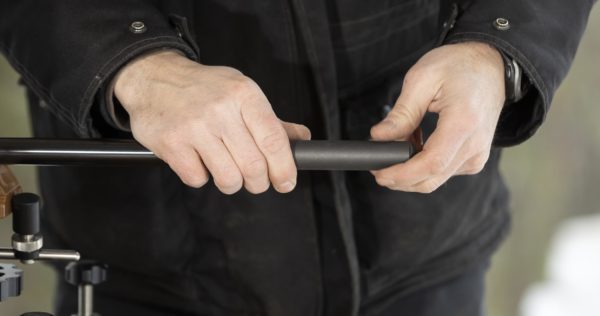
We tested three configurations: bare muzzle (with thread cap), with DefCan, and with the Alamo at both 50 yards and 100 yards.
Results
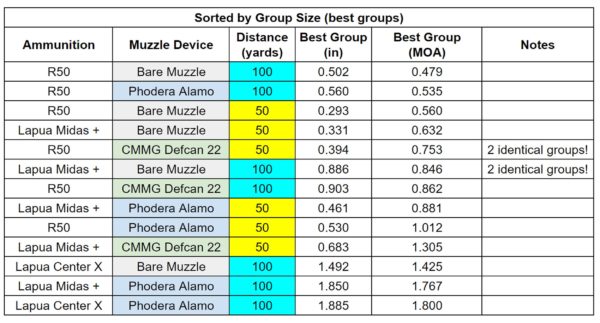
I thought groups would open more at 100 yards with more non-linear dispersion. There was actually no significant difference at 50 yards or 100 yards. I suspected the MOA would be better at 50 yards because of wind, but there wasn’t much during our test. The smallest group in terms of MOA (0.479 MOA) was fired at 100 yards, as was the largest group (1.800 MOA).
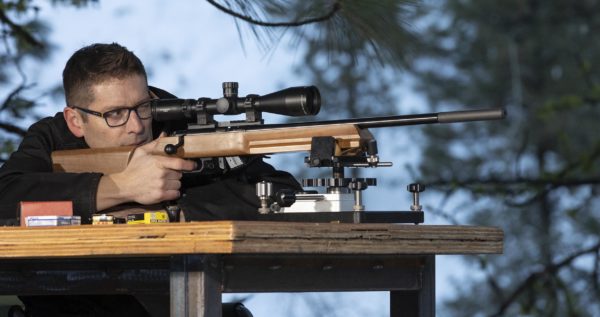
To have a ½ sub-MOA group at 100 yards with a rimfire is incredibly impressive. Rimfires are notorious for being very picky about ammunition. I’ve found that my Anschutz 54.18 can shoot incredibly well when paired with ammunition it likes. Having an accurate rifle is key to isolating factors, as we are in this test.
As an aside, two configurations/combinations had identical groups for both of the two strings. Both of the strings fired with R50 and the CMMG DefCan 22 at 50 yards and fired with Lapua Midas + with bare muzzle at 100 yards were within three thousandths of an inch of one another.
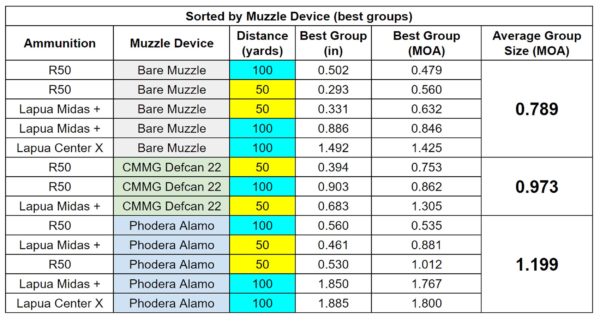
Looking at the muzzle device configuration, the bare muzzle did the best with an average group size of 0.789 MOA. The DefCan 22 followed with an average group size of 0.973 MOA then the Phodera Alamo at 1.199 MOA. Keep in mind this doesn’t mean it is impossible to have good groups with the Phodera. One of the best groups, 0.560 inches at 100 yards, was fired with R50 and the Phodera Alamo. I really believe that not only are rimfire rifles particular about their ammunition, each configuration for a rimfire rifle has its own preferences.
Conclusion
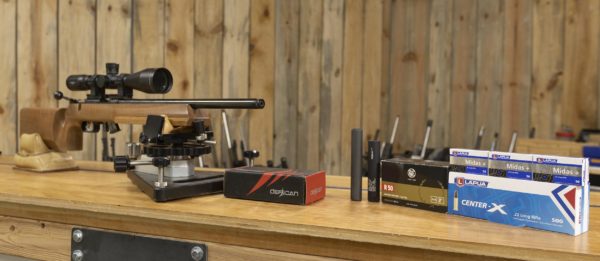
Our limited data set clearly shows the best groups came with the bare muzzle. Rimfire suppressors did open up the groups, but MOA was consistent between 50 yards and 100 yards across the board. We also concluded that ammunition is a very significant variable. Every rifle, and each configuration, likes something different. For example, some of the worst groups from the initial test were fired with ammunition that performs extremely well in other guns I have.
With rimfire, I don’t have the option to control variables through reloading. It is possible that the suppressor doesn’t actually change shot dispersion, but instead changes the barrel tune. This would require more ammunition testing to investigate, but I do believe rimfire suppressors do alter shot dispersion, but perhaps the effect can be mitigated. A 30 caliber suppressor (greater clearance) would also be an interesting test.
Get the Gear
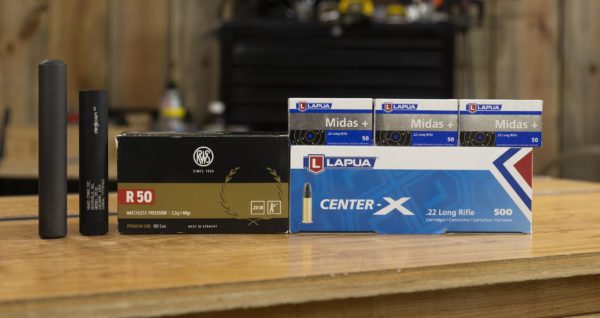
Anschutz 54.18 Match BR50-U7 20” Threaded (shown on video)
CMMG DefCan 22 Rimfire Suppressor
All Anschutz 54.18 Models Rimfire Suppressor
Rimfire ammunition available at Creedmoor Sports:
Athlon Midas TAC 5-25x56mm Scope
Sinclair Competition Shooting Rest
Protektor Model Bags, front and rear
Don’t miss out on Ultimate Reloader updates, make sure you’re subscribed!
Thanks,
Gavin Gear
